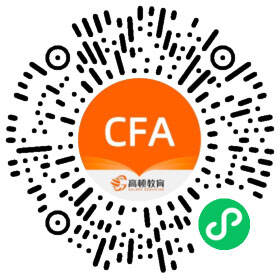
报考指南:2014年CFA考试备考指南
免费题库:2014年CFA免费题库
考前冲刺:CFA备考秘籍
高清网课:CFA考试网络课程



1、凡本网站注明“来源高顿教育”或“来源高顿网校”或“来源高顿”,的所有作品,均为本网站合法拥有版权的作品,未经本网站授权,任何媒体、网站、个人不得转载、链接、转帖或以其他方式使用。
2、经本网站合法授权的,应在授权范围内使用,且使用时必须注明“来源高顿网校”或“来源高顿”,并不得对作品中出现的“高顿”字样进行删减、替换等。违反上述声明者,本网站将依法追究其法律责任。
3、本网站的部分资料转载自互联网,均尽力标明作者和出处。本网站转载的目的在于传递更多信息,并不意味着赞同其观点或证实其描述,本网站不对其真实性负责。
4、如您认为本网站刊载作品涉及版权等问题,请与本网站联系(邮箱fawu@gaodun.com,电话:021-31587497),本网站核实确认后会尽快予以处理。
CFA(Chartered Financial Analyst)金融分析师考试是全球最受尊重和最难的金融考试之一。考试分为三个等级,每个等级的考试难度都在逐渐增加。CFA考试是专业...
2023-05-10CFA是金融领域最为知名的证书之一,拥有CFA证书可以帮助金融分析师获得更好的职业发展机会和更高的薪资待遇。而要获得CFA证书,则需要通过三级考试,...
2023-05-06金融分析师CFA考试没有时效性,但考生需要注意的是,CFA协会限制了考生报考CFA考试的次数。根据CFA协会的规定,考生有六次机会参加各金融分析师考试。...
2023-04-27精算师和金融分析师哪个更好?哪个更容易找到工作?精算师和金融分析师是数据解释的核心职业。这两个职业都取决于智能和分析问题的解决方案,...
2023-04-26刚进入或即将进入金融行业的学生可能听说过CFA金融证书。今天,我将介绍CFA证书和相关费用。具体情况下面请跟随candy学姐一起来看看吧~...
2023-04-23CFA共有10个科目,包括10个CFA一级和二级科目,只有7个CFA三级科目。具体情况下面请跟随candy学姐一起来看看吧~...
2023-04-23据说caf证书吸引了很多人报名是因为金融分析师年薪高。真的是这样吗?当然,赚钱很香,但是参加CAF考试还是有很多好处的。你知道吗?今天candy学姐就...
2023-05-18CFA,又称特许金融分析师,金融领域内含金量超高的证书,那么cfa金融分析师考试科目都有哪些,考试题型是什么样的?今天candy学姐就来带领大家一起来...
2023-04-18今天学姐收到来自小伙伴的提问:“cfa一级二级三级的区别在哪里?cfa考试考察重点在哪里?”小编在这里统一回复一下大家的问题,下面请跟随小编一起...
2023-04-17为什么说随机模型更容易受管理人员主观判断的影响
老师,超定额废品损失是什么?
老师,题目说a是3阶矩阵有3各不同特征值,这能推出什么结论,和秩有怎样的关系呢,这里想不过来
叉车的最低折旧年限是多少?
销售部门上缴1万元,未存入银行 。这个不需要在对账单里+1吗
为什么说随机模型更容易受管理人员主观判断的影响
老师,超定额废品损失是什么?
老师,题目说a是3阶矩阵有3各不同特征值,这能推出什么结论,和秩有怎样的关系呢,这里想不过来
叉车的最低折旧年限是多少?
销售部门上缴1万元,未存入银行 。这个不需要在对账单里+1吗
2023年CFA证书考试内容及考试科目详细!CFA考试作为全球金融行业内最具有声望和权威性的认证之一,其考试难度也是相对较高的。CFA考试包含三个等级,每个等级都有非常严格的考试标准和要求,要求考生具备非常扎实的金融学和投资学知识,具有较高的分析能力和解决问题的能力。...
2023-05-16CFA一级、二级、三级有什么不同?最近有小伙伴咨询到小编这个问题,今天小编就来统一回复以下大家的问题,下面请跟随candy学姐一起来看看吧~...
2023-05-16CFA考试是金融业的重要认证考试。对于那些想在金融领域发展的人来说,获得CFA证书是必不可少的一步。但是CFA考试比较难,考生复习需要花费大量的时间和精力。本文将为您提供一些CFA考试复习策略,帮助您关注细节,准确掌握知识点,提高CFA考试通过率。今天小编就来好好跟大家聊聊这个话题,下面请.........
2023-05-11CFA(Chartered Financial Analyst)金融分析师考试是全球最受尊重和最难的金融考试之一。考试分为三个等级,每个等级的考试难度都在逐渐增加。CFA考试是专业金融领域的标志性资格认证,拥有CFA资格的人被认为是金融行业的精英,具有很高的市场价值和职业发展空间。今天candy学姐就来好好跟大家一起讲讲这.........
2023-05-10根据CFA协会的统计数据,通过三级考试平均需要3年左右。有些朋友,可能因为各种原因,不能坚持到最后,只通过了一级。但你知道吗,没通过一级考试待遇都不一样,为啥这么说呢,今天candy学姐就来带领大家一起来一探究竟,下面跟随小编一起来看看吧~...
2023-03-29CFA,也就是说,特许金融分析师,被称为“金融第一考试”的CFA考试,涵盖了金融领域的所有知识点。CFA考试包括哪些科目?考试内容是什么?今天candy学姐就来好好跟大家一起聊聊这个话题,下面跟随小编一起来看看吧!...
2023-03-272023年CFA考试安排是什么?附考试科目和题型介绍!2023年CFA考试分为三个层次:CFA一级考试、CFA二级考试和CFA三级考试。三级考试的科目和题型不同。今天小编就从多个方面跟大家进行详细的解答,一起来看看吧~...
2023-05-18CFA考试分为一级、二级和三级。由于CFA在国际金融领域享有“金融第一考试”的美誉,很多考生担心CFA考试难度会很高。CFA考试难度如何?今天,candy将带您进行全面的分析,让我们来看看~...
2023-05-18汇总!2023年CFA一二三级考纲变化更改解读!2023年度CFA考试还未开考,但是协会官方已经发布了2023年CFA考试大纲的变动,参加23年CFA考试的考生,请务必关注考纲变化,提前做好备考准备。...
2023-05-042023cfa换考纲了,cfa每年考纲都会变吗?是的,如果不出意外,cfa考试的考纲每年都会更新,变化可以达到10%-20%,如果跨年份准备学习、进行考试的考生一定要注意这些变化,会给大家的考试带来一定的影响。 一、cfa考纲变化 1、CFA一级的考纲变化 2022年CFA一级大部分科目的考纲都发生了变化,虽然Session总.........
2022-09-012023cfa一级考纲已换,对考试有什么影响?cfa考试的考纲已经更新了,每年考纲的变化可谓是万众瞩目,毕竟关乎到自己学习的内容。网上有人说据考纲看这次考试可能难度加大了,比较担心。不如和小编一起看看考纲有哪些变化,对我们的cfa考试有什么影响吧。 一、cfa考纲变化 2022年CFA一级大部分科目的.........
2022-09-012023年cfa考试的考纲已经公布了,这次的变化的规模不小,一二三都有所变动,2023年考试的考生应该注意了。毕竟变的地方极其有可能是重点,相当于把考点递到眼前,必须要手下啊。现在一起看看:2023年cfa考试的考纲怎么变化!怎么进行复习? 一、cfa考试变化 (1)简述CFA一级变动 变化内容:财报、F.........
2022-09-02CFA协会在2022年8月9日的时候公布了2023年二级最新的考纲。学姐发现2023年的考试大纲除了CFA三级没有变动,一级还有二级考试都多少有所改动。所以针对新考纲部分,大家需要重点学习。 CFA二级的10门科目中有5门科目的考纲改变分别是:数量、财报,公司金融、权益,另类。 考纲发生微小变化的有1个:经.........
2022-08-222023年CFA大纲丨CFA一级、二级有变,三级无变化!当前2023年2月、5月CFA报名窗口均已开放,三个级别考试均有对应的报名窗口,并且随着报名窗口的开放,2023年CFA一级、二级以及三级考纲也已经公布。...
2023-05-04